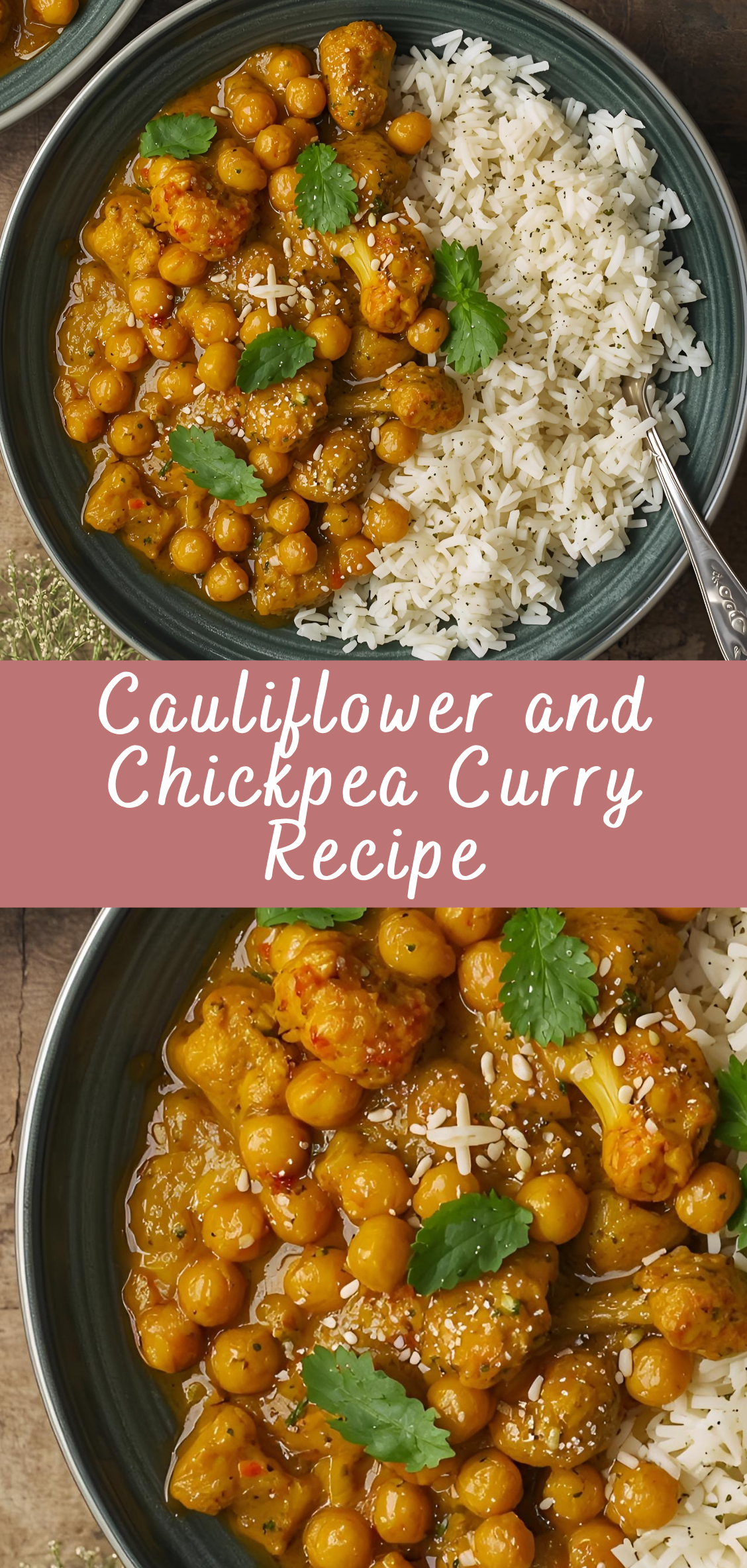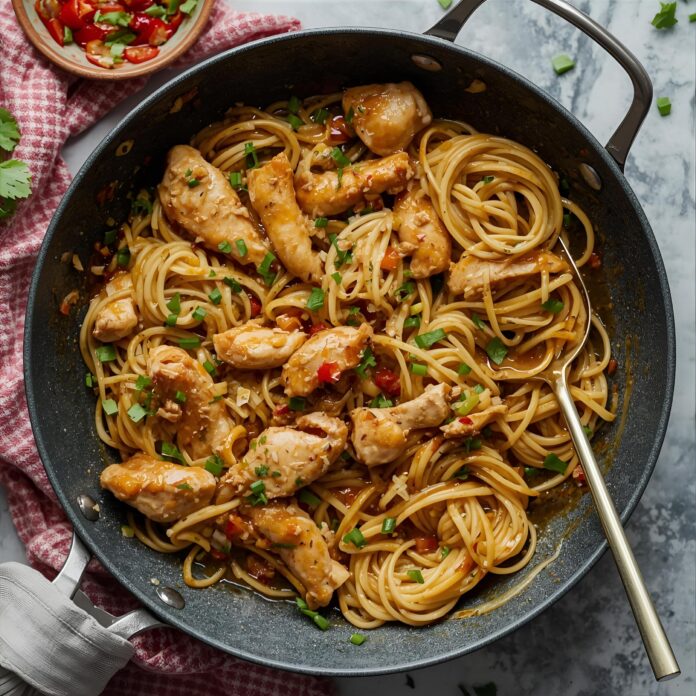Cauliflower and Chickpea Curry: A Hearty, Flavorful Plant-Based Delight
In recent years, the world of plant-based cooking has seen a remarkable surge in creativity and innovation. Among the myriad of dishes that celebrate vegetables as the main attraction, curry holds a special place. Its ability to transform humble ingredients into a rich, comforting, and deeply satisfying meal is nothing short of magical. One such dish that exemplifies this is the Cauliflower and Chickpea Curry—a warm, nourishing bowl of goodness that beautifully marries simplicity with bold flavors.

Rooted in the culinary traditions of South Asia and embraced globally for its versatility, this curry is more than just a vegetarian option—it’s a dish that satisfies meat-eaters and plant-based enthusiasts alike. With its rich tapestry of spices, creamy texture, and hearty components, it’s a staple that deserves a spot in every home cook’s rotation.
Cauliflower and chickpeas are a natural pairing. Cauliflower, with its mild, nutty taste and meaty texture, absorbs spices like a sponge, while chickpeas (or garbanzo beans) provide a satisfying bite and a boost of plant-based protein. Together, they form a robust foundation for a curry that is as comforting as it is nutritious.
This dish also offers a canvas for customization, whether you prefer a fiery kick, a creamy coconut base, or a tomato-forward sauce. It can be served over fluffy basmati rice, scooped up with warm naan bread, or enjoyed on its own as a hearty stew. Whether you’re cooking for a weeknight dinner, meal prepping for the week, or impressing guests at a dinner party, cauliflower and chickpea curry rises to the occasion every time.
In the following sections, we’ll dive deep into the origins of the dish, the health benefits of its star ingredients, essential spices, step-by-step instructions, variations to suit different palates, and tips to make your curry absolutely foolproof. Whether you’re a novice home cook or a seasoned chef looking to refine your curry-making skills, this comprehensive guide is designed to equip you with everything you need to master the perfect cauliflower and chickpea curry.
Let’s begin this flavorful journey.
Detailed Instructions: Step-by-Step Guide to Making Cauliflower and Chickpea Curry
Creating a rich and flavorful curry is more than just following a recipe—it’s about layering flavors, understanding your ingredients, and cooking with patience. This step-by-step guide provides detailed instructions, tips, and explanations to help you confidently prepare a delicious Cauliflower and Chickpea Curry from scratch.
Section 1: Gather and Prep the Ingredients
Before you begin cooking, it’s essential to have all your ingredients prepared and measured. This step, known as mise en place, is a fundamental practice in professional kitchens and makes the cooking process smoother and more enjoyable.
Ingredients List
Vegetables & Legumes:
-
1 medium head of cauliflower, cut into florets
-
1 can (15 oz) chickpeas (garbanzo beans), drained and rinsed
-
1 large onion, finely diced
-
3 cloves garlic, minced
-
1 tablespoon fresh ginger, grated
-
1–2 medium tomatoes, chopped (or 1/2 cup canned crushed tomatoes)
-
1–2 green chilies, finely chopped (optional for heat)
-
1 cup fresh spinach or kale (optional, for added greens)
Spices & Seasonings:
-
1 tablespoon curry powder (mild or hot)
-
1 teaspoon ground turmeric
-
1 teaspoon ground cumin
-
1 teaspoon ground coriander
-
1/2 teaspoon smoked paprika (optional, adds depth)
-
1/4 teaspoon ground cinnamon (optional, adds warmth)
-
Salt to taste (start with 1 teaspoon)
-
Freshly ground black pepper to taste
Liquids & Fats:
-
2 tablespoons oil (coconut oil, olive oil, or vegetable oil)
-
1 can (13.5 oz) full-fat coconut milk
-
1/2 cup water or vegetable broth (more if needed for consistency)
-
Juice of half a lemon or lime (for acidity and brightness)
Optional Garnishes:
-
Fresh cilantro, chopped
-
Toasted cashews or slivered almonds
-
Red chili flakes
-
A dollop of vegan yogurt or dairy-based yogurt
Preparation Steps:
-
Chop the cauliflower into bite-sized florets, ensuring relatively uniform pieces for even cooking.
-
Rinse the chickpeas thoroughly under cold water to remove excess sodium and preservatives if using canned.
-
Dice the onions, mince the garlic, and grate the fresh ginger. These aromatic ingredients form the flavorful base of the curry.
-
Measure out your spices in a small bowl or set them beside your cooking area for easy access.
-
Optional but recommended: Lightly toast whole cumin or coriander seeds if using fresh whole spices for added flavor (then grind).
Section 2: Building the Flavor Base (Masala)
A great curry begins with a solid flavor base, commonly known as the masala in South Asian cuisine. This base consists of aromatic vegetables sautéed in oil and layered with spices.
Instructions:
-
Heat the oil in a large, heavy-bottomed pan or Dutch oven over medium heat. Allow the oil to heat up for about 30 seconds to a minute. It should shimmer but not smoke.
-
Add the diced onions to the pan and sauté for 6–8 minutes, stirring occasionally. You’re aiming for a golden brown color. This slow cooking of the onions caramelizes their natural sugars and adds depth to the curry.
-
Once the onions begin to brown, add the garlic, ginger, and green chilies (if using). Sauté for another 2 minutes, stirring frequently to avoid burning the garlic. The mixture should become fragrant.
-
Stir in the ground spices: curry powder, turmeric, cumin, coriander, smoked paprika, and cinnamon. Stir continuously for 30–60 seconds to toast the spices slightly and release their essential oils. This is a crucial step—do not skip it or rush it.
-
Deglaze the pan with a few tablespoons of water or vegetable broth if the mixture begins to stick. This lifts the flavorful bits from the bottom of the pan into the masala.
Section 3: Simmering the Curry
Now that the flavor base is ready, it’s time to bring in the main ingredients and develop the body of the curry.
Instructions:
-
Add the chopped tomatoes to the masala and stir to combine. Let the tomatoes cook down for 5–7 minutes, until they break apart and meld into the mixture. If using canned crushed tomatoes, this may take slightly less time.
-
Once the tomatoes have softened and the mixture is thick, add the cauliflower florets. Stir well to coat the cauliflower in the spice mixture. Sauté for 3–5 minutes to give the cauliflower a slight sear and to deepen the flavor.
-
Add the chickpeas and stir again to combine. Let everything cook together for another 2 minutes to meld the flavors.
-
Pour in the coconut milk and water or broth, stirring gently to combine. The curry should have a creamy consistency—not too watery, but enough liquid to simmer the vegetables.
-
Season with salt and pepper at this stage, tasting the liquid to adjust as needed.
-
Bring the curry to a gentle boil, then reduce the heat to low or medium-low and cover with a lid. Allow it to simmer for 15–20 minutes, or until the cauliflower is fork-tender but not mushy.
-
Stir occasionally during simmering to prevent sticking, and adjust the liquid level as needed. If the curry looks too thick, add a splash of water or broth; if too thin, let it simmer uncovered for a few minutes.
Section 4: Final Touches and Balancing Flavors
A great curry balances flavors: heat, sweetness, acidity, and umami. The final steps elevate the dish from good to exceptional.
Instructions:
-
Once the cauliflower is fully cooked, taste the curry. Add more salt, a touch of sugar, or chili flakes depending on your preference.
-
For brightness and contrast, squeeze in the juice of half a lemon or lime just before serving. This cuts through the richness of the coconut milk and wakes up the flavors.
-
If adding greens, such as spinach or kale, stir them in now. They’ll wilt in the residual heat in about 2–3 minutes.
-
For a creamier texture, you can blend a cup of the curry in a blender and return it to the pot, or use an immersion blender to slightly purée part of the curry directly in the pot. This thickens the sauce naturally without adding flour or cream.
-
Let the curry rest for 5 minutes off the heat before serving. Like most curries, it will taste even better after sitting a bit.
Section 5: Serving Suggestions
How you serve your curry can transform it into a complete meal or an elegant dinner spread.
-
With rice: Serve over fluffy basmati, jasmine, or brown rice.
-
With flatbread: Pair with warm naan, roti, or paratha to scoop up the curry.
-
As a stew: Enjoy on its own as a thick, hearty bowl with a side of lime and herbs.
-
With toppings: Garnish with fresh cilantro, toasted nuts, and a spoon of yogurt or vegan alternative.
Optional additions:
-
A side of pickled onions or mango chutney for contrast
-
A dollop of coconut cream for extra richness
-
Chopped fresh tomatoes or cucumber for freshness
Cauliflower and Chickpea Curry Recipe
In recent years, the world of plant-based cooking has seen a remarkable surge in creativity and innovation. Among the myriad of dishes that celebrate vegetables as the main attraction, curry holds a special place. Its ability to transform humble ingredients into a rich, comforting, and deeply satisfying meal is nothing short of magical. One such dish that exemplifies this is the Cauliflower and Chickpea Curry—a warm, nourishing bowl of goodness that beautifully marries simplicity with bold flavors.
Ingredients
- 1 tablespoon vegetable oil (or coconut oil)
- 1 medium onion, finely chopped
- 3 cloves garlic, minced
- 1 tablespoon fresh ginger, grated
- 1 tablespoon curry powder
- 1 teaspoon ground cumin
- 1/2 teaspoon ground turmeric
- 1/4 teaspoon cayenne pepper (optional, to taste)
- 1 medium cauliflower, cut into florets
- 1 can (15 oz) chickpeas, drained and rinsed
- 1 can (14.5 oz) diced tomatoes
- 1 can (14 oz) coconut milk (full-fat or light)
- Salt, to taste
- Black pepper, to taste
- 1 tablespoon lemon juice or lime juice (optional, for brightness)
- Fresh cilantro, chopped, for garnish
- Cooked rice or naan, for serving
Instructions
- Sauté aromatics:
Heat oil in a large skillet or pot over medium heat. Add the chopped onion and sauté for 5–6 minutes until softened. - Add garlic and spices:
Stir in the garlic, ginger, curry powder, cumin, turmeric, and cayenne (if using). Cook for 1–2 minutes until fragrant. - Add cauliflower and chickpeas:
Add the cauliflower florets and chickpeas. Stir well to coat with the spice mixture. - Add liquids:
Pour in the diced tomatoes (with juices) and coconut milk. Stir to combine. Bring to a simmer. - Simmer until tender:
Cover and simmer on medium-low heat for 20–25 minutes, or until the cauliflower is tender and the curry has thickened slightly. Stir occasionally. - Season and finish:
Add salt and pepper to taste. Stir in lemon or lime juice, if using. - Serve:
Spoon over rice or serve with naan. Garnish with fresh chopped cilantro.
Notes
- Spice level: Adjust cayenne or use chili flakes to control the heat.
- Vegan & gluten-free: Naturally vegan and gluten-free as written.
- Add-ins: You can add spinach or kale during the last 5 minutes of cooking for extra greens.
- Make ahead: Tastes even better the next day as the flavors develop.

